
Lepidoptera or lepidopterans is an order of winged insects which includes butterflies and moths. About 180,000 species of the Lepidoptera have been described, representing 10% of the total described species of living organisms, making it the second largest insect order with 126 families and 46 superfamilies, and one of the most widespread and widely recognizable insect orders in the world.

Bombyx mori, commonly known as the domestic silk moth, is a moth species belonging to the family Bombycidae. It is the closest relative of Bombyx mandarina, the wild silk moth. Silkworms are the larvae of silk moths. The silkworm is of particular economic value, being a primary producer of silk. The silkworm's preferred food are the leaves of white mulberry, though they may eat other species of mulberry, and even leaves of other plants like the osage orange. Domestic silk moths are entirely dependent on humans for reproduction, as a result of millennia of selective breeding. Wild silk moths, which are other species of Bombyx, are not as commercially viable in the production of silk.

Saturniidae, members of which are commonly named the saturniids, is a family of Lepidoptera with an estimated 2,300 described species. The family contains some of the largest species of moths in the world. Notable members include the emperor moths, royal moths, and giant silk moths.
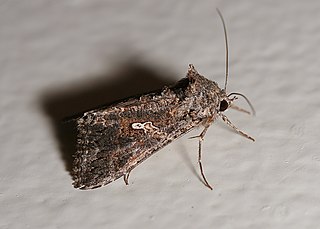
The cabbage looper is a medium-sized moth in the family Noctuidae, a family commonly referred to as owlet moths. Its common name comes from its preferred host plants and distinctive crawling behavior. Cruciferous vegetables, such as cabbage, bok choy, and broccoli, are its main host plant; hence, the reference to cabbage in its common name. The larva is called a looper because it arches its back into a loop when it crawls.

Bombykol is a pheromone released by the female silkworm moth to attract mates. It is also the sex pheromone in the wild silk moth. Discovered by Adolf Butenandt in 1959, it was the first pheromone to be characterized chemically.

Bombyx is the genus of true silk moths or mulberry silk moths of the family Bombycidae, also known as silkworms, which are the larvae or caterpillars of silk moths. The genus was erected as a subgenus by Carl Linnaeus in his 10th edition of Systema Naturae (1758).

The Silkworm is a 2014 crime fiction novel written by J. K. Rowling, and published under the pseudonym Robert Galbraith. It is the second novel in the Cormoran Strike series of detective novels and was followed by Career of Evil in 2015, Lethal White in 2018,Troubled Blood in 2020, The Ink Black Heart in 2022 and The Running Grave in 2023.

Samia cynthia, the ailanthus silkmoth, is a saturniid moth, used to produce silk fabric but not as domesticated as the silkworm, Bombyx mori. The moth has very large wings of 113–125 mm (4.4–4.9 in), with a quarter-moon shaped spot on both the upper and lower wings, whitish and yellow stripes and brown background. There are eyespots on the outer forewings. The species was first described by Dru Drury in 1773.

The Bombycidae are a family of moths known as silkworm moths. The best-known species is Bombyx mori (Linnaeus), or domestic silk moth, native to northern China and domesticated for millennia. Another well-known species is Bombyx mandarina, also native to Asia.

Bombyx mandarina, the wild silk moth, is a species of moth in the family Bombycidae. It is the closest relative of Bombyx mori, the domesticated silk moth. The silkworm is the larva or caterpillar of a silk moth. Unlike the domesticated relative which is unable to fly or indeed persist outside human care, the wild silk moth is a fairly ordinary lepidopteran. Its main difference from the domesticated taxon is the more slender body with well-developed wings in males, and the dull greyish-brown colour.

Insects have mouthparts that may vary greatly across insect species, as they are adapted to particular modes of feeding. The earliest insects had chewing mouthparts. Most specialisation of mouthparts are for piercing and sucking, and this mode of feeding has evolved a number of times independently. For example, mosquitoes and aphids both pierce and suck, though female mosquitoes feed on animal blood whereas aphids feed on plant fluids.
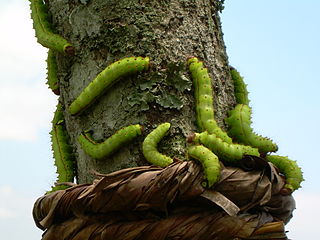
Wild silks have been known and used in many countries from early times, although the scale of production is far smaller than that from cultivated silkworms. Silk cocoons and nests often resemble paper or cloth, and their use has arisen independently in many societies.
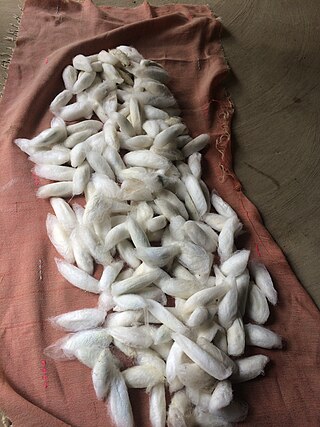
Eri silk is a type of peace silk produced by the domesticated silkworm Samia ricini. It is primarily produced in the northeastern Indian states of Assam, Nagaland and Meghalaya, but it is also found in Bihar, Odisha, West Bengal and Andhra Pradesh on a smaller scale. It was imported to Thailand in 1974.

Cricula trifenestrata, the cricula silkmoth, is a species of wild silk moth of the family Saturniidae. It is found from India to the Philippines, Sulawesi, Java, and Sri Lanka.

Antheraea pernyi, the Chinese oak tussar moth, Chinese tasar moth, or temperate tussar moth, is a large moth in the family Saturniidae. The species was first described by Félix Édouard Guérin-Méneville in 1855. Antheraea roylei is an extremely close relative, and the present species might actually have evolved from ancestral A. roylei by chromosome rearrangement.

Antheraea paphia, known as the South India small tussore, the tasar silkworm and vanya silkworm is a species of moth of the family Saturniidae found in India and Sri Lanka. The bulk of the literature on this species uses a junior synonym, Antheraea mylitta, rather than the correct name, A. paphia. It is one of a number of tasar silkworms, species that produce Tussar silk, a kind of wild silk that is made from the products of saturniid silkworms instead of the domesticated silkworm.
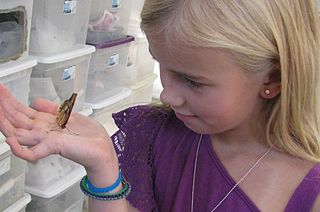
Commercial butterfly breeding or captive butterfly breeding is the practice of breeding butterflies and moths in controlled environments to supply the stock to research facilities, universities, zoos, insectariums, elementary and secondary schools, butterfly exhibits, conservation organizations, nature centers, individuals, and other commercial facilities. Some butterfly and moth breeders limit their market to wholesale customers while other breeders supply smaller volumes of stock as a retail activity. Some small scale and larger scale breeders limit their businesses to the provision of butterflies or moths for schools. Others provide butterflies to be used and released in commemorative events. The release usually occurs in the natural range of the butterfly.
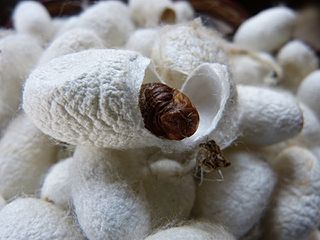
Ahimsa silk, also known as peace silk is a method of nonviolent silk breeding and harvesting. Wild silk moths are bred rather than the domestic variety. It allows the completion of the metamorphosis of the silkworm to its moth stage, whereas most silk harvesting requires the silkworms to be killed in their cocoon stage. No animals suffer or die for the silk to be produced, making it a favorable alternative to normal silk for those who object to harming animals.
Boris Lvovich Astaurov was a Soviet and Russian biologist and geneticist who worked on breeding experiments including pioneering work on silkworms, in which he demonstrated the induction of parthenogenesis, polyploidy, and cloning. He produced fertile tetraploid hybrids of the silkworm species Bombyx mori and Bombyxmandarina. Astaurov was among the few Mendelian geneticists who survived Stalin's purge.
Antheraea roylei is a large moth in the family Saturniidae occurring in Nepal, Thailand, Burma, Vietnam, West Malaysia, and the Himalayan regions of India. The species is considered to be the wild progenitor of the domesticated species known as Antheraea pernyi; the theory is that pernyi may have evolved from ancestral A. roylei by chromosome rearrangement during domestication.

















